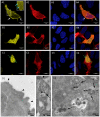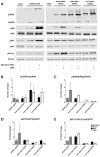Membrane-Associated, Not Cytoplasmic or Nuclear, FGFR1 Induces Neuronal Differentiation
- PMID: 30875802
- PMCID: PMC6468866
- DOI: 10.3390/cells8030243
Membrane-Associated, Not Cytoplasmic or Nuclear, FGFR1 Induces Neuronal Differentiation
Abstract
The intracellular transport of receptor tyrosine kinases results in the differential activation of various signaling pathways. In this study, optogenetic stimulation of fibroblast growth factor receptor type 1 (FGFR1) was performed to study the effects of subcellular targeting of receptor kinases on signaling and neurite outgrowth. The catalytic domain of FGFR1 fused to the algal light-oxygen-voltage-sensing (LOV) domain was directed to different cellular compartments (plasma membrane, cytoplasm and nucleus) in human embryonic kidney (HEK293) and pheochromocytoma (PC12) cells. Blue light stimulation elevated the pERK and pPLCγ1 levels in membrane-opto-FGFR1-transfected cells similarly to ligand-induced receptor activation; however, no changes in pAKT levels were observed. PC12 cells transfected with membrane-opto-FGFR1 exhibited significantly longer neurites after light stimulation than after growth factor treatment, and significantly more neurites extended from their cell bodies. The activation of cytoplasmic FGFR1 kinase enhanced ERK signaling in HEK293 cells but not in PC12 cells and did not induce neuronal differentiation. The stimulation of FGFR1 kinase in the nucleus also did not result in signaling changes or neurite outgrowth. We conclude that FGFR1 kinase needs to be associated with membranes to induce the differentiation of PC12 cells mainly via ERK activation.
Keywords: AKT; ERK; FGF2; HEK293; PC12; neurite outgrowth; optogenetics; receptor kinase.
Conflict of interest statement
The authors declare no conflict of interest.
Figures





Similar articles
-
Light-mediated kinetic control reveals the temporal effect of the Raf/MEK/ERK pathway in PC12 cell neurite outgrowth.PLoS One. 2014 Mar 25;9(3):e92917. doi: 10.1371/journal.pone.0092917. eCollection 2014. PLoS One. 2014. PMID: 24667437 Free PMC article.
-
cAMP-induced differentiation of human neuronal progenitor cells is mediated by nuclear fibroblast growth factor receptor-1 (FGFR1).J Neurochem. 2003 Mar;84(6):1296-312. doi: 10.1046/j.1471-4159.2003.01624.x. J Neurochem. 2003. PMID: 12614330
-
Endocytosis and Transport of Growth Factor Receptors in Peripheral Axon Regeneration: Novel Lessons from Neurons Expressing Lysine-Deficient FGF Receptor Type 1 in vitro.Anat Rec (Hoboken). 2019 Aug;302(8):1268-1275. doi: 10.1002/ar.24120. Epub 2019 Apr 22. Anat Rec (Hoboken). 2019. PMID: 30950230 Free PMC article.
-
Integrative nuclear FGFR1 signaling (INFS) as a part of a universal "feed-forward-and-gate" signaling module that controls cell growth and differentiation.J Cell Biochem. 2003 Nov 1;90(4):662-91. doi: 10.1002/jcb.10606. J Cell Biochem. 2003. PMID: 14587025 Review.
-
Integrative nuclear signaling in cell development--a role for FGF receptor-1.DNA Cell Biol. 2007 Dec;26(12):811-26. doi: 10.1089/dna.2007.0664. DNA Cell Biol. 2007. PMID: 18021009 Review.
Cited by
-
Fibroblast growth factor receptor 1-bound extracellular vesicle as novel therapy for osteoarthritis.Biomedicine (Taipei). 2022 Jun 1;12(2):1-9. doi: 10.37796/2211-8039.1308. eCollection 2022. Biomedicine (Taipei). 2022. PMID: 35836973 Free PMC article. Review.
-
New developments in the biology of fibroblast growth factors.WIREs Mech Dis. 2022 Jul;14(4):e1549. doi: 10.1002/wsbm.1549. Epub 2022 Feb 9. WIREs Mech Dis. 2022. PMID: 35142107 Free PMC article. Review.
-
The TNFR Wengen regulates the FGF pathway by an unconventional mechanism.Nat Commun. 2023 Sep 21;14(1):5874. doi: 10.1038/s41467-023-41549-3. Nat Commun. 2023. PMID: 37735159 Free PMC article.
-
Fibroblast Growth Factor Signalling in the Diseased Nervous System.Mol Neurobiol. 2021 Aug;58(8):3884-3902. doi: 10.1007/s12035-021-02367-0. Epub 2021 Apr 15. Mol Neurobiol. 2021. PMID: 33860438 Free PMC article. Review.
-
Bacterial Phytochrome as a Scaffold for Engineering of Receptor Tyrosine Kinases Controlled with Near-Infrared Light.J Mol Biol. 2020 Jun 12;432(13):3749-3760. doi: 10.1016/j.jmb.2020.04.005. Epub 2020 Apr 14. J Mol Biol. 2020. PMID: 32302608 Free PMC article.
References
Publication types
MeSH terms
Substances
LinkOut - more resources
Full Text Sources
Research Materials
Miscellaneous

